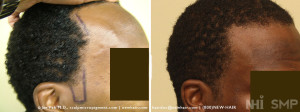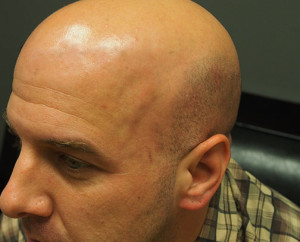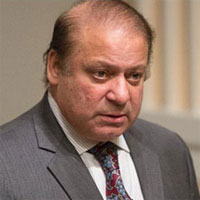Dr. Russell Knudsen (from Australia) wrote in informative article in this months “Hair Transplant Forum International”. Clearly, the ability to harvest the donor area with FUE will be more restrictive in individuals who have more extensive balding patterns (Class 5, 6 and 7 patterns of balding). The donor area around the sides and back of the head reflect 25% of the original total hair count on the head (I call it my 25% rule). If one targets somewhere between half or 2/3rds of the follicular units found in the donor area, as the maximum safe yield for FUE over time, then for Caucasians with average hair density (100,000 hairs on their head or 50,000 follicular units in the permanent zone) might be able to safely harvest as much as between 6,250 (half) or 8,250 (2/3rds) from the 12,500 follicular units in the permanent zone (25% rule).
In those individuals with higher densities than 100,000 hairs on their head, the harvestable follicular unit numbers may safely go higher, while in the typical Asian, for example with lower hair densities (80,000 hairs on their head or 40,000 follicular units), the donor area would contain only 10,000 follicular units. With half of the Asian’s 10,000 follicular units harvested, that leaves 5,000 follicular units behind (this reflects a calculation of 25% of the birth hair follicular unit numbers which are permanent). I believe that extracting between one out of every two follicular units from the permanent zone may be pushing the limit on people with low density hair.
There may be reasonable limits for a typical Asian based upon hair density (we calculate hair density on every patient undergoing hair transplant surgery). To complicate matters, Asian follicular unit hair counts average less than two hairs per follicular unit, so to get out an average of two hair FUE grafts, it takes more follicular units to yield an average of two hair FUE grafts. Asians (or Caucasians with low hair density) who have a high number of FUEs will, in my opinion, be thin looking around the back and sides of the head. I have seen some Asians with significant track marks from the punch scars created by FUE, particularly when the harvesting numbers are high and the remaining donor hair is significantly lessened.
Many doctors are taking hair from the non-permanent area to give the patient the benefits of more hair in the transplant; however, this may spell disaster for the patient who develops more extensive balding (suggested by Dr. Knudsen). Hair taken from the non-permanent area will be lost with aging and/or advancement of the balding patterns. Over zealous FUE beyond the permanent zone, has long term consequences for some patients and they must be warned. I have seen some patients who’s balding had accelerated from multiple FUE procedures and have loss hair in areas where FUE grafts were taken while leaving visible scars.
I want to raise blood supply issues here as I have seen one patient already who had received 6700 FUE grafts in two sessions and lost more hair in the permanent zone than was removed by the surgeon during the FUE. I actually counted the grafts and the hairs on the head and had done density studies on him before another surgeon did surgery on him. When FUE numbers are pushed, this patient’s findings suggested vascular compromise may have occurred impacting the remaining hair in the donor area. I have heard, second hand, that at the last ISHRS meeting some cases of necrosis have appeared in the donor area when too many FUEs were done, possibly too close together. I don’t believe we really understanding the complications of large FUE sessions, or that doctors are not reporting their complications out of fear of professional ridicule and/or malpractice risks, all of which may become a factor in the long term future of this surgery. As we do many FUE cases in our practice, we are not anti-FUE; however, aggressive FUE megasessions in the wrong hands could be a problem.
In conclusion, “do FUE surgeries change donor area planning”, the answer is YES. FUE will impact long term planning and may impact strip surgery in future surgeries. Low density donor areas, resulting from FUE, make for less donor hair for a strip surgery, which will only make any scarring more visible as the hair is cut short.





 Nawaz Sharif could fill up the frontal area with another procedure and get some more hair on the top of his head, but as has a Norwood class 7 balding pattern with what appears to be fine hair, I doubt that he will ever look completely full.
Nawaz Sharif could fill up the frontal area with another procedure and get some more hair on the top of his head, but as has a Norwood class 7 balding pattern with what appears to be fine hair, I doubt that he will ever look completely full. It it generally thought that ACell will help the healing process deep in the wound and possibly reduce the superficial scarring, thereby making better wounds. There is circumstantial evidence for this in our practice, but this is more conjecture than science. I have not seen that ACell has helped the graft healing or made it grow better.
It it generally thought that ACell will help the healing process deep in the wound and possibly reduce the superficial scarring, thereby making better wounds. There is circumstantial evidence for this in our practice, but this is more conjecture than science. I have not seen that ACell has helped the graft healing or made it grow better.